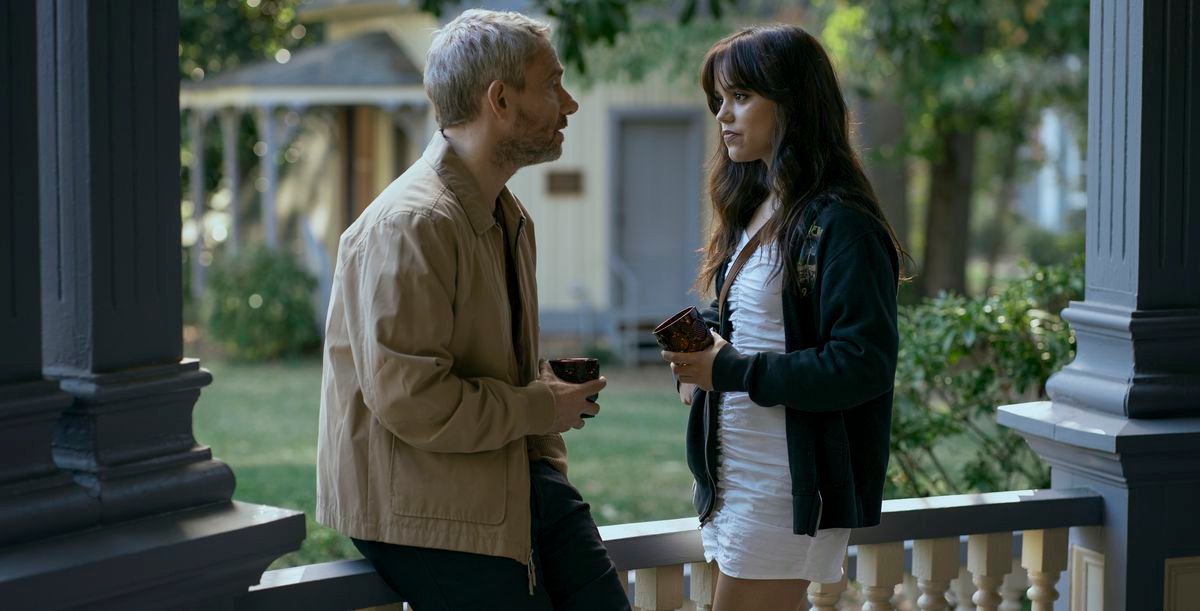This piece on Miller’s Girl was originally published in connection with the film’s theatrical release. It has been updated and republished for the film’s arrival on Netflix.
No matter how often the argument resurfaces, we aren’t really running out of movie stars — especially not as far as fandom is concerned. There are still plenty of actors out there with devotees who eagerly track their faves from project to project. Jenna Ortega has built that kind of following, from her child-actor phase as a Disney TV stalwart to playing young Jane on Jane the Virgin, the title role in Netflix’s Wednesday, and one of the new crop of knife-fodder-to-be in the Scream reboot series. Her fans have been vocal about the excitement of seeing her take on more adult, more independent, and more ambitious roles. But they’re going to have an interesting time figuring out how to swallow her latest movie Miller’s Girl, now that it’s arrived on Netflix.
Anyone who felt distanced from their peers in high school and ready to move on to the adult world should find an initial spark of recognition in Jade Halley Bartlett’s writing and directing debut. Miller’s Girl stars Ortega as the improbably named Cairo Sweet, a rich high-school trust-funder living a decadent life alone in a vast house while her parents travel. Cairo seems infinitely bored with everything but her own fulsome, over-the-top writing. She briefly finds a kindred spirit in one of her teachers, Jonathan Miller, played by Marvel Cinematic Universe/Peter Jackson’s Hobbit movies/Cornetto trilogy veteran Martin Freeman. Given how jaded they both are with everything else, and how quickly they fascinate each other, it’s no surprise that this teacher-student relationship quickly goes wrong.
What is surprising, though, is how Miller’s Girl just as quickly loses the plot, and loses everyone around Cairo in the effort to center the story on her.
A lot’s been said lately about whether movies are getting longer on average, and whether that’s a problem for anyone, apart from the usual internet kvetchers, or theater owners who want to churn through showings faster. But where the tight 90-minute thriller still has significant appeal, Miller’s Girl’s scant 93 minutes make a strong argument for longer movies. In this case, it really could have used the extra run time to develop its characters.
Miller’s Girl is a small story with just a few central characters, but most of them are broad, cartoonish types reminiscent of the first season of Glee. Cairo’s best friend, Winnie (Gideon Adlon), is a flirtatious virgin who’s a nonstop fountain of come-ons and sex talk, until she suddenly flips into a completely different mode halfway through the film. Her sharp left turn is much more justified than the one taken by Jon’s wife, Beatrice (Dagmara Dominczyk): She starts out as an amiable workaholic who’s three-quarters checked out of her marriage, then abruptly becomes a lurching alcoholic whose jabs at her husband are straight out of Who’s Afraid of Virginia Woolf?

Photo: Zac Popik/Lionsgate
But the movie’s biggest problem is the relationship between Jon and Cairo, which moves from a queasy, dangerous early connection to a third-act meltdown so abruptly that it feels like it’s entirely missing the second act. It’s hard to say how exactly Bartlett sees their relationship: Depending on the scene and whose point of view it’s from, Jon comes across as an understandably lonely man who just admires his student’s writing, or a schmuck making all his decisions below the waist. Cairo, for her part, veers back and forth between Wild Things-level schemer and an awkward, isolated teenager who isn’t yet capable of seeing that she can’t claim her teacher as a soulmate — at least, not if he has a scrap of moral fiber or sense of appropriateness in his body.
Miller’s Girl is a lush, even overripe movie, full of grandiloquent voiceover from Cairo’s writing, alongside snippets of other characters’ equally gushy work. (An excerpt from one of the short stories Cairo confidently offers Jon: “Survival and desire amalgamated, and turned an aphotic eye inward. I saw my expectations dismantled and dismembered by the harsh and starving dogs of reality, truths that sit in the vacuity of space like a hyper-giant star, burning to ash all elements too weak to withstand the awesome heat.”) Cairo takes frequently banned author Henry Miller as a writing inspiration, clutching her copy of Under the Roofs of Paris as she navigates high school. Her admiration for his work shows clearly in her wordiness, her calculated ennui, and her determination to push the boundaries of censorship by turning her writing assignments into sexual fantasies.
Miller’s Girl’s visuals and production design are frequently dark and saturated with rich, heavy color, and Bartlett weaves in and out of fantasy elements to illustrate her points of view. It’s compelling visual storytelling, but whether the narrative elements work for any given viewer will depend heavily on whether they find writing like the above evocative, or just pretentious and excruciating.

Image: Lionsgate
What Miller’s Girl does best — and what gives Ortega the chance to absolutely own this movie — is capture the particular era of adolescence where girls can easily swing back and forth between adulthood and childhood without warning. Ortega gets the chance here to play an outright predatory vamp and a giggling, shy schoolgirl without the sense that either one is a front or a put-on for Cairo. Her adult personality isn’t fully formed yet, and while she’s trying out identities the way she tries out words like “vituperative” in her writing, they’re still all part of her — and they’re all part of the reason Mr. Miller should know better than to engage with her as anything but a student.
The adult characters similarly veer between personalities, though — Jon included. And they just seem inconsistent, bound to whatever the story needs in a given scene. The last act is rushed and forced, without the space it needs to give any of these characters their due, or give the audience any cue about how to take the leads and their relationship. Netflix’s May December walked similar ground in navigating the later-life fallout of a sexual relationship between a teacher and her young student, but it explored the same ambiguities with nuance and significant thought. Miller’s Girl just skims the surface, and settles for making that surface look visually sumptuous.
None of which may matter to Ortega’s fans, who get to see enough range from her here to make the excursion worthwhile. Miller’s Girl is a luxuriant meal for her, a chance to play a variety of facets of the same girl while finding the connections between them. For everyone else, though, it’s short rations, and more than a little underbaked.
Miller’s Girl is now streaming on Netflix, and can be rented or purchased on Google Play, Amazon Video, and other digital platforms.















































